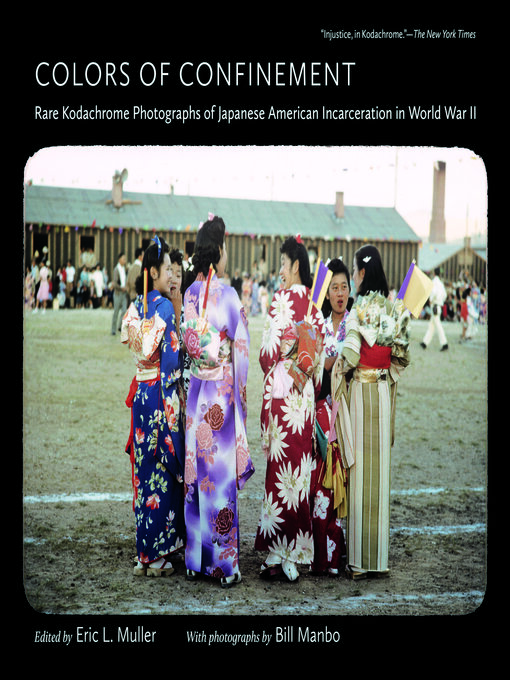Colors of Confinement
Rare Kodachrome Photographs of Japanese American Incarceration in World War II
The subjects of these haunting photos are the routine fare of an amateur photographer: parades, cultural events, people at play, Manbo's son. But the images are set against the backdrop of the barbed-wire enclosure surrounding the Heart Mountain Relocation Center and the dramatic expanse of Wyoming sky and landscape. The accompanying essays illuminate these scenes as they trace a tumultuous history unfolding just beyond the camera's lens, giving readers insight into Japanese American cultural life and the stark realities of life in the camps.
Also contributing to the book are:
Jasmine Alinder is associate professor of history at the University of Wisconsin–Milwaukee, where she coordinates the program in public history. In 2009 she published Moving Images: Photography and the Japanese American Incarceration (University of Illinois Press). She has also published articles and essays on photography and incarceration, including one on the work of contemporary photographer Patrick Nagatani in the newly released catalog Desire for Magic: Patrick Nagatani — Works, 1976–2006 (University of New Mexico Art Museum, 2009). She is currently working on a book on photography and the law.
Lon Kurashige is associate professor of history and American studies and ethnicity at the University of Southern California. His scholarship focuses on racial ideologies, politics of identity, emigration and immigration, historiography, cultural enactments, and social reproduction, particularly as they pertain to Asians in the United States. His exploration of Japanese American assimilation and cultural retention, Japanese American Celebration and Conflict: A History of Ethnic Identity and Festival, 1934–1990 (University of California Press, 2002), won the History Book Award from the Association for Asian American Studies in 2004. He has published essays and reviews on the incarceration of Japanese Americans and has coedited with Alice Yang Murray an anthology of documents and essays, Major Problems in Asian American History (Cengage, 2003).
Bacon Sakatani was born to immigrant Japanese parents in El Monte, California, twenty miles east of Los Angeles, in 1929. From the first through the fifth grade, he attended a segregated school for Hispanics and Japanese. Shortly after Pearl Harbor, his family was confined at Pomona Assembly Center and then later transferred to the Heart Mountain Relocation Center in Wyoming. When the war ended in 1945, his family relocated to Idaho and then returned to California. He graduated from Mount San Antonio Community College. Soon after the Korean War began, he served with the U.S. Army Engineers in Korea. He held a variety of jobs but learned computer programming and retired from that career in 1992. He has been active in Heart Mountain camp activities and with the Japanese American Korean War Veterans.
-
Creators
-
Series
-
Publisher
-
Release date
August 13, 2012 -
Formats
-
Kindle Book
-
OverDrive Read
- ISBN: 9780807837580
- File size: 8593 KB
-
EPUB ebook
- ISBN: 9780807837580
- File size: 8593 KB
-
-
Languages
- English
-
Reviews
-
Publisher's Weekly
July 16, 2012
In this provocative and noteworthy collection, published in association with the Center for Documentary Studies at Duke University, legal scholar Muller (American Inquisition: The Hunt for Japanese American Disloyalty in World War II) presents 65 photographs made from slides he discovered that were taken by photographer Manbo, a Japanese-American interned at the Heart Mountain Relocation Center in Wyoming during WWII. Manbo was active in the camp’s photo club and operated in the vernacular style, shooting color slide film, a recently developed technology and one that was rarely used to document the internment camps. Manbo shot not just the traditional camp views of bleakly uniform buildings, but parades, pastimes, cultural rituals, and family portraits (many of his adorable young son, Billy). The vivid color enhances the pageantry of the events, and the family photos seem almost strangely normal, while another photo shows a toddler gripping the camp’s barbed wire. The book’s three accompanying essays and one memoir of the camp, each by a different author, provide context, and while the photos could mostly be classified as snapshots, their subject matter and the use of Kodachrome film solidifies their unquestionable cultural and historical significance. Photos. -
Library Journal
Starred review from August 1, 2012
In 1942, Manbo (1908-1992) and his family were uprooted from their home in Hollywood and moved into a Japanese-American internment camp at Heart Mountain in Wyoming. While living there, Manbo made a series of photographs in Kodachrome, which was then a relatively new and little-used color slide film. In muted colors, he captured the beauty, resilience, and vitality of people--family and friends--forced to make a new life for themselves in that bleak place. Muller (Dan K. Moore Distinguished Professor of Law in Jurisprudence and Ethics, Univ. of North Carolina Sch. of Law; American Inquisition: The Hunt for Japanese American Disloyalty in World War II) selected the 65 images included in the book and the four essays, one of which he contributed. VERDICT The strength of this title is the photography: Manbo documents a people who rose above persecution and injustice to carry on traditions and form a community in a barren landscape. Anyone interested in documentary photography and American social and cultural history will appreciate this book. Highly recommended.--Raymond Bial, First Light Photography, Urbana, IL
Copyright 2012 Library Journal, LLC Used with permission.
-
Formats
- Kindle Book
- OverDrive Read
- EPUB ebook
subjects
Languages
- English
Loading
Why is availability limited?
×Availability can change throughout the month based on the library's budget. You can still place a hold on the title, and your hold will be automatically filled as soon as the title is available again.
The Kindle Book format for this title is not supported on:
×Read-along ebook
×The OverDrive Read format of this ebook has professional narration that plays while you read in your browser. Learn more here.


